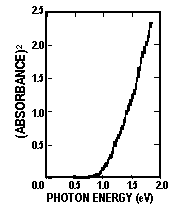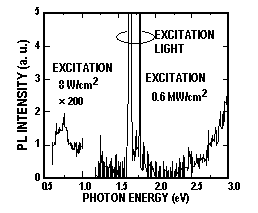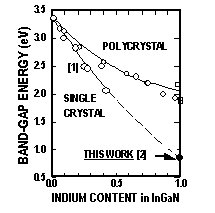Physical Science Laboratory
In the InGaAlN system we proposed [1], which has been applied for blue-green LEDs and so on, InN remains the most mysterious compound, due mainly to difficulty in growing high-quality crystals because of the extremely high equilibrium vapor pressure of nitrogen. A typical issue is the fundamental band gap Eg. Early absorption studies on poly-crystalline films reported Eg=1.8-2.0 eV at room temperature. All of those samples showed no corresponding band-edge photoluminescence (PL). On the other hand, based on a series of absorption experiments on high-quality wurtzite InXGa1-XN films, Eg decreased monotonically from 3.4 eV (x=0) to 2.1 eV (x=0.42), and it was pointed out that InN single crystals would have a much smaller Eg than commonly believed [1]. In this report, it is described that single crystalline InN has a band-gap energy of 0.8 eV.
High-quality wurtzite InN was successfully grown on a (0001) sapphire substrate using metalorganic vapor phase epitaxy (MOVPE) at ambient pressure. The growth temperature was 500oC. Trimethylindium (TMI) and ammonia as were the source gases, and their flow rate was 1 to 6 μmol/min and 15 slm, respectively. The V/III flow rate ratio was adopted to be large enough to suppress the indium precipitation in the film. As a carrier gas, nitrogen was used instead of hydrogen to promote ammonia decomposition.
A typical result of the absorption at room temperature is shown in Fig. 1, which plots as absorbance squared versus photon energy. Extrapolation of the linear region to the horizontal axis gives Eg = 0.8-1.0 eV. In PL spectra measured at room temperature as shown in Fig. 2, the PL peak was observed at 0.76 eV. Even under the high power excitation of 0.6 MW/cm2, no PL was observed near the previous "band gap" energy. Eg for InGaN containing InN are plotted in Fig. 3, including InN [2]. Eg for polycrystals is larger than that for single crystals. By fitting a quadratic curve to the data from optical absorption using least-squares method, Eg of 0.85 eV for InN was obtained.
To conclude, the above mentioned results strongly suggest that Eg of InN should be near 0.8 eV. Precisely determining Eg of InN will require a thicker InN film of higher quality with low carrier density. The discrepancy from previous data could be due to differences in crystallinity. Due to this work, the application field of InGaAlN is extended to infrared.
| [1] | T. Matsuoka et al., Proc. Int. Symp. on GaAs and Related Comps, Karuizawa, Japan, 1989, 141. |
| [2] | T. Matsuoka et al., Appl. Phys. Lett. 81 (2002) 1246. |
 |
 |
 |
||||||
|
|
|